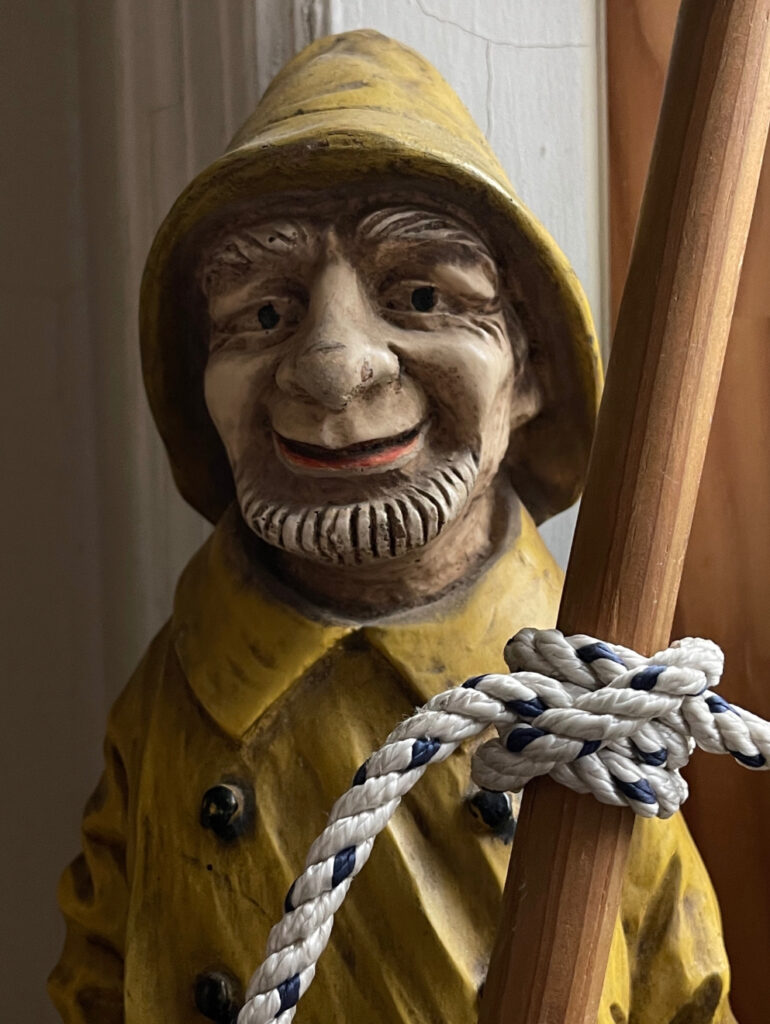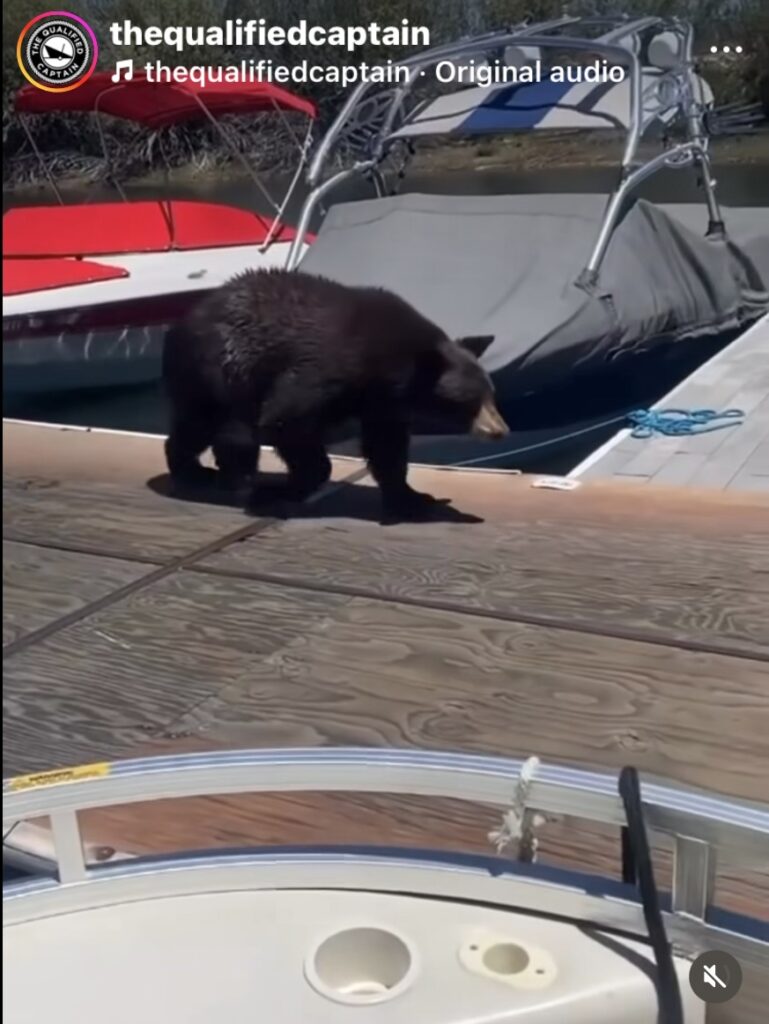It’s probably a not-a-knot, and when you learn how to sail with us, you learn how not to tie them! Or, just take our upcoming Knot-Tying Clinic.
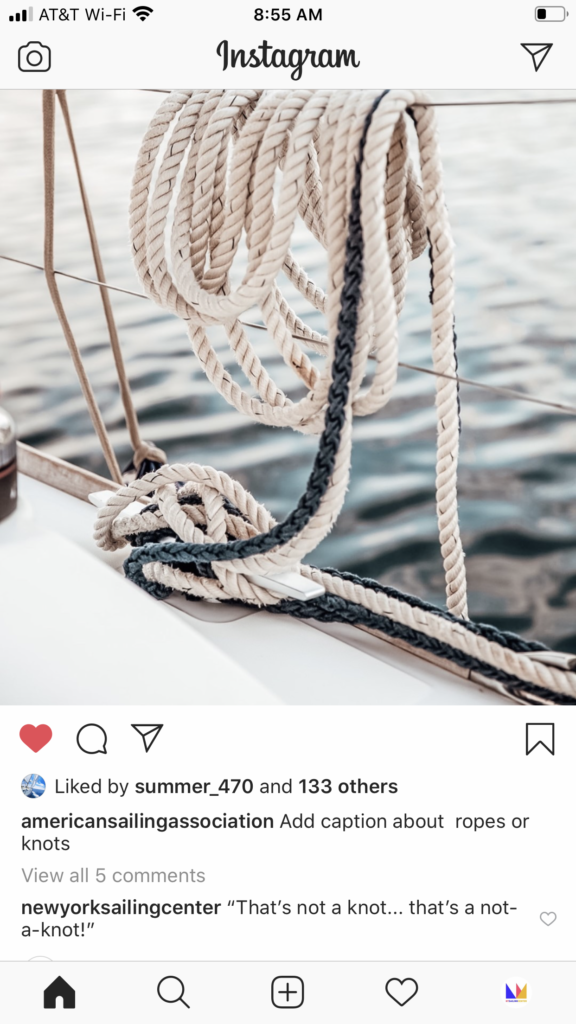
Knots are curious creatures. Sometimes they actually look like creatures; hermit crabs come to mind with some “stopper” knots. Often, they’re elegant. A few good knots can go a long way; some people know a f-ton of knots but aren’t so savvy on application.
We had one guy join us for our Start Bareboating course (ASA 104, Bareboat Cruising) around 10 years ago. He was a very nice guy; decent sailor; professional technical photographer. And, he loved knots. Knew multiples more than anyone I know did (including me). Why?
“I’m an insomniac. When I can’t sleep, I get out my knot book and learn a few more.”
That was all well and good, but he got a little green under the hood out on the Sound one day and I think we had to come in early. I know he didn’t show up the next day. Sad.
Anywho…
KNOT TYING CLINIC: click that link to visit that page on our site and see if you wanna join us on Sunday March 2 for a few hours.
I learned most of my limited repertoire of boating/sailing knots a very long time ago. So, I don’t remember how I learned them. I also learned some fishing knots way back when. I do remember revisiting fishing knots in my 20’s when I got back in that activity after a bit of an absence. At some point, I bought a book on fishing knots. Way more than anyone would need, of course, but still… options. One stood out, which I believe I also found in an article. The Uni Knot! One and done. It really works for so many applications it’s the only knot I use for fishing.
But, for sailing, one can’t rely exclusively on any single knot. To get ASA 101 Keelboat certification one is supposed to learn 6 knots. Their descriptions are covered on the written test. Schools are supposed to observe that students can tie them. I’m far less interested in how many knots a sailor can tie than I am whether they can rig the boat, get underway safely, avoid other boats, and sail back to and stop at the mooring without an engine. The rest of the knots can come later. But, they are important – especially if poorly tied and something gets away.
On our Sailing Vacay destination trips, in the Caribbean and Mediterranean, our cruising charter yachts come equipped with dinghies for getting around once anchored or moored. We had one get away from us.
Twice. (Ugh)
1st time: someone apparently took it upon themself to re-tie the dinghy after I’d secured it very well with a proper cleat hitch. We were on a 40-footer towing a 9’ dink. This was our second day out, and we were en route to the island of Paxos off the Ionian coast of Greece. We were more than half way along with a lot of fairly open water astern and not much ahead. You know, islands… I looked back for whatever reason; possibly to check my fishing line. I was likely trolling off the back of the boat to see if we were lucky enough to catch fresh for din din.
No dink!
Called down for the binos. Someone kindly brought them up and i looked back and couldn’t see a dink. But, eventually I spotted it drifting. We lost some time backtracking and returning, and this was valuable time to get situated at an unfamiliar anchorage before dusk to not only enjoy the evening but to get anchored or moored safely before dark. Didn’t figure out who did it, but someone did. (I was confident it was one of two people; those same two people left our trip the next day to the relief of all others. Happens. Rarely, but it happens. This was the final straw on accepting people from Meetup to come on our trips; that ship sailed. Actually, that ship sank.)
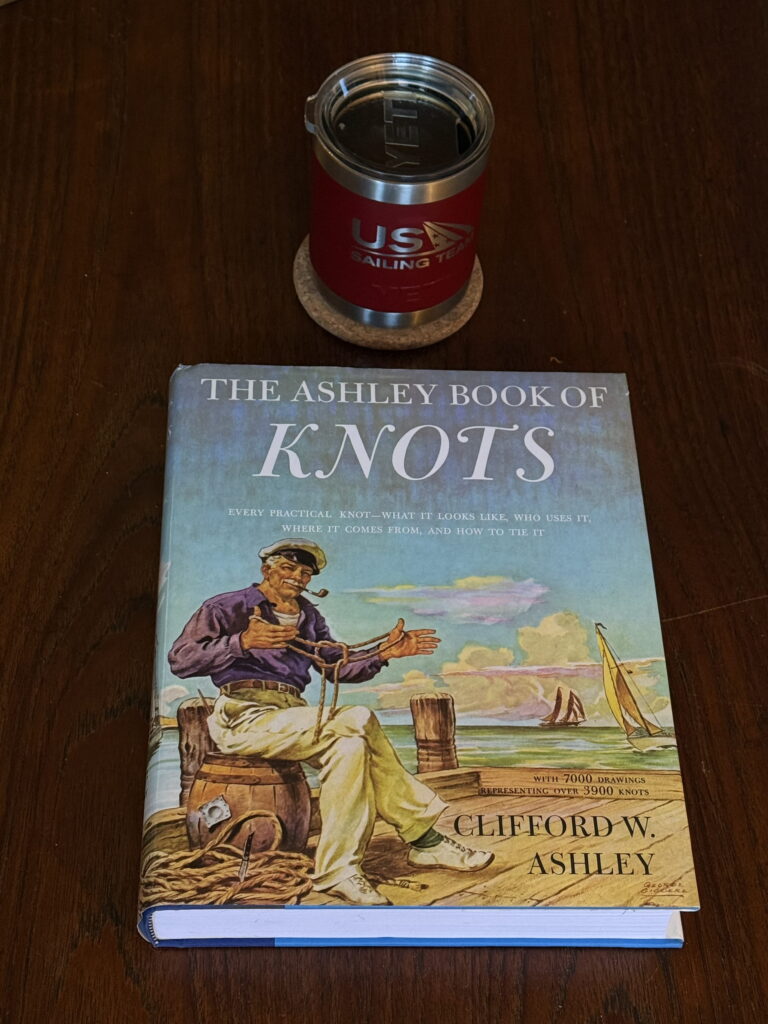
Fast forward a few years; back in the BVI, our winter stomping grounds. It was windy and gusty and we were sailing with a quartering sea from Jost Van Dyke to Norman Island, by way of Thatch Cut. Thatch are two islands off the west end of Tortola. One passes between the extreme west end of Tortola, which is a mini-peninsula with a bluff – very scenic. That cuts across the mouth of Sopers Hole, a very protected bay on Tortola, and past the Thatches. Once beyond Tortola, you’re in the channel between it and St. John, and onward to other islands (in our case, Norman).
We had a family aboard; self-described affable Type A’s including two or three lawyers. Couple; their adult daughter; sister/aunt. They were indeed affable; but the husband was also sometimes arrogant and defensive boarding on belligerent. We had not sailed with them before. (Starting to see a pattern?)
For the second time on the trip, this time during our windy leg from Jost to Norman, the husband started getting into it with me out of the blue. This time it was to protest how a task that was also an educational segment went wrong. The task was to figure out the reefing system on the boat for future use (assigned days before). Then, the application: that morning, before we left the anchorage. They struggled to figure it out but eventually did with little or no guidance from me.
But, hubby was angry about it. He didn’t like two things: one, how I went about teaching it; two, which he didn’t admit, how he struggled with it. He could be self-critical but was quicker to blame others for his own failures. This wasn’t a test; it was a learning experience, and therefore a success! But he didn’t see it that way.
I tried to keep it smooth and let him know that there were a number of ways I could have assigned that task or taught the procedure. I chose one. If he and/or others didn’t like the choice/method, that’s fine – I wouldn’t use that again and would do something that fit in better with their learning preferences. But, he wouldn’t leave it alone. He got angrier and louder.
He weren’t no hermit…
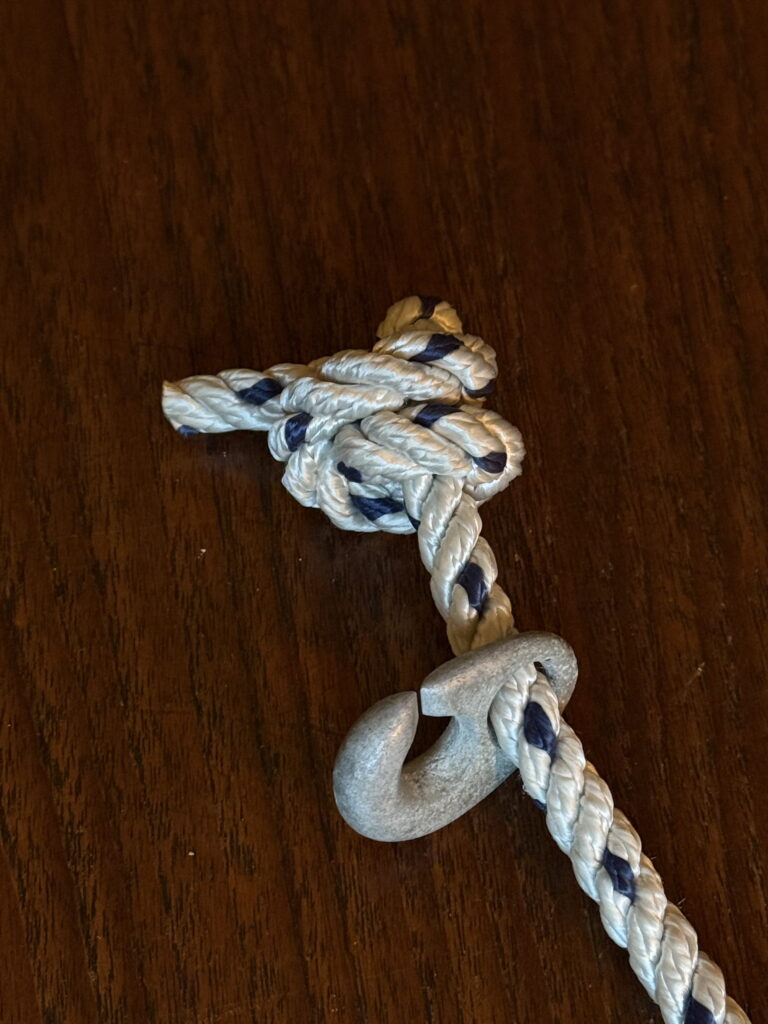
I kept my voice down after at one point starting to raise mine to be heard over his. I explained that he had to calm down and keep his voice down – happy to discuss and debate, but not going to be yelling. When he still wouldn’t calm down, despite some of the family telling him to shut up, I said something like this:
”Look, here’s what’s going to happen. If you keep yelling, I’m going to just get this boat through the trip and eventually back to the charter base. I’m not going to teach anything. You’re not going to get the certification you are here for. I’m just going to shut up and get the boat from A to B to C. And that’s going to be the end of it.”
”Ray, SHUT UP!”
-entire fam in unison
That time, he did. We got through to Sopers Hole and I suggested we stop for docking practice and maybe some ice cream or something. Sounded great to all. Ray eventually was joking around instead of fighting with me. He dialed it back including when we got ashore, when I half expected him to start up again.
I was walking along the dock with my friend John who was on the trip with his wife Lydia. We were on route to the store and John said, “where’s the dinghy?”
I looked around and saw none. Silence.
Gone. Last time I saw it was when it was surfing behind us on the swells that were developing en route to Tortola. I was checking that it wasn’t going to ride up on the transom of the yacht, and that it wasn’t yanking hard on the painter (tow line). As it looked fine, I didn’t adjust it.
But, that was then, and this was now. I called the charter company to advise and ask if they had any ability to look, and I started hailing on the VHF to see if any vessels in that area had seen it or might keep an eye out for it.
Gone. They brought us another dinghy in a short period of time, and we were on our way. Of course, I forfeited the security deposit for the lost dinghy. That was some expensive ice cream! Probably would have seen the dinghy get loose if it weren’t for Ray. I see everything; it is known. This time I didn’t. That was the first nail in the coffin for people joining us on our destination trips if we haven’t sailed with them before in a course setting. Another trip two years ago was the final nail that closed the coffin for good; the only strange we allow on the boat is when friends or family join people we’ve already sailed with, and then only if we do the due diligence to make sure they’re a good fit and really understand what they’re getting involved with and what the “real estate” is like on a small charter yacht (versus an ocean liner).
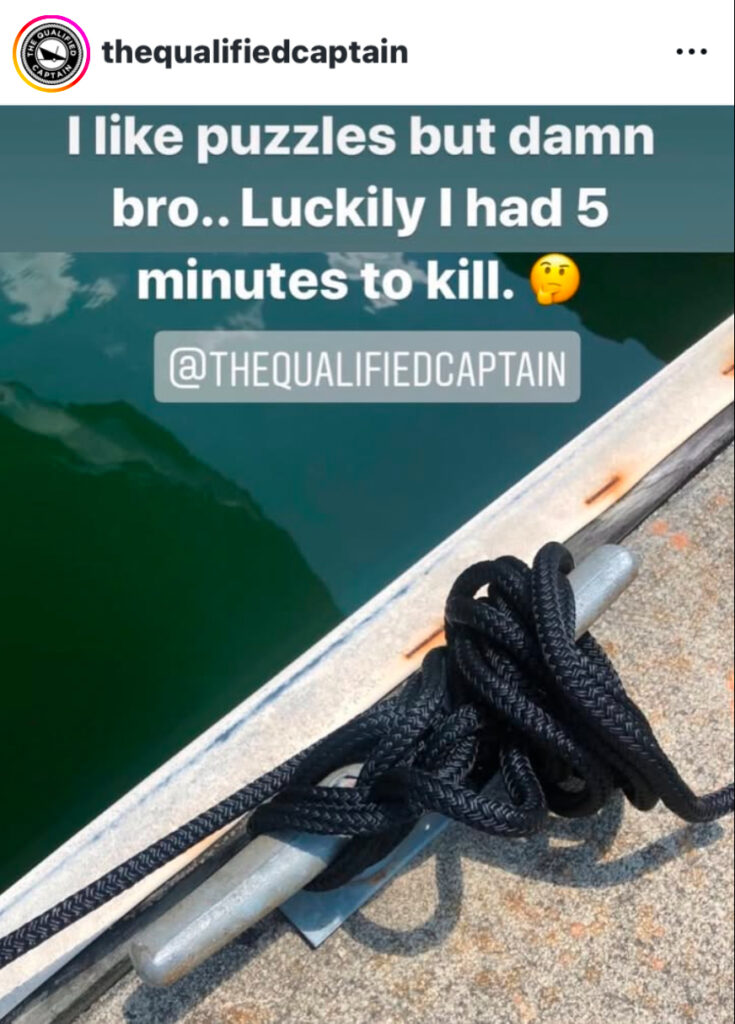
The knot that failed both times? Cleat hitch. Main reason? Probably the material. Dinghies are usually tied off with a type of plastic line that floats called polypropylene. It’s not just a bitch to tie right; it’s a war-time whore. It must be overly wrapped in many ways with locking hitches in between, and then I usually tie the end to something else. I check. Often.
The cleat hitch is one of the least understood knots out there in my (potentially dubious) opinion. There are standard caveats about how to tie it that I can prove wrong to you in the knot clinic. They miss one important point about how to start the cleat hitch that sets it up for success or failure (meaning either it will slip, which is unlikely despite the experiences described above, or it will be hard to untie when critically necessary).
”Marlinspike seamanship!” It’s a fascinating if misogynistic-sounding world. Maybe some of you will come tie one on with us at the clinic. If not, read up, practice, and apply on the water and at the dock and have fun with it.
KNOT TYING CLINIC: click that link to visit that page on our site and see if you wanna join.
Just want that book? Multiples of scores of more knots than the clinic for just under twice the price. But, diagrams don’t explain how to handle the rope and close knots properly, which is a large drawback. For under $100, you should probably do both! Here’s the book link on Amazon…
Ashley Book of Knots: https://a.co/d/5toAElR
IN THIS PIC: the author’s favorite knot. Know it? You ought to.
